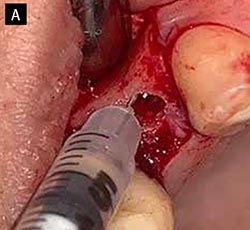Changes of peri-implant bone density in relation to local application of alendronate and/or recombinant human bone morphogenetic protein-2: A randomized controlled clinical study

Submitted: 11 August 2021
Accepted: 23 February 2022
Published: 23 September 2022
Accepted: 23 February 2022
Abstract Views: 380
pdf: 418
Publisher's note
All claims expressed in this article are solely those of the authors and do not necessarily represent those of their affiliated organizations, or those of the publisher, the editors and the reviewers. Any product that may be evaluated in this article or claim that may be made by its manufacturer is not guaranteed or endorsed by the publisher.
All claims expressed in this article are solely those of the authors and do not necessarily represent those of their affiliated organizations, or those of the publisher, the editors and the reviewers. Any product that may be evaluated in this article or claim that may be made by its manufacturer is not guaranteed or endorsed by the publisher.


 https://doi.org/10.23805/JO.2022.14.30
https://doi.org/10.23805/JO.2022.14.30








